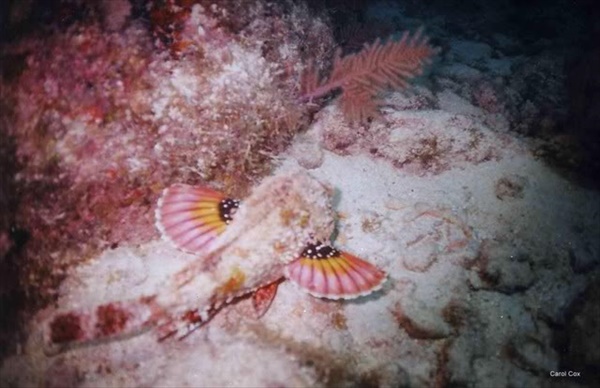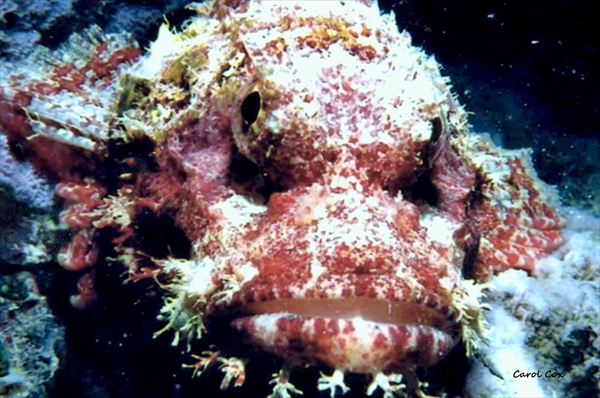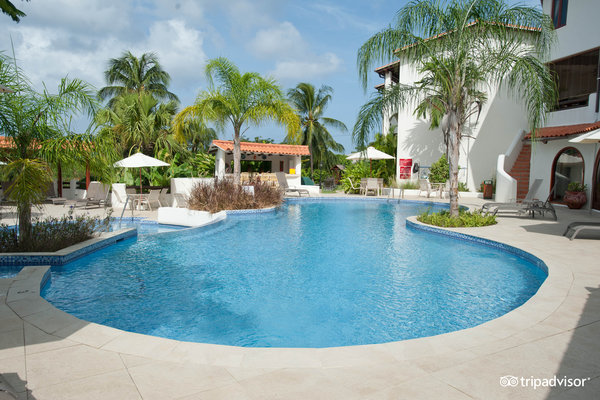![]()
- Scuba Skills Tune-up Event
- Be the First on Your Block...
- ADA Season Kickoff and BBQ
- Photography, Part 3 - Choosing a Camera
- Scorpionfish
- Diving Writers and Writing Divers Wanted
- Fiji Redeux
- New Online ADA Calendar Available
- First Annual ADA Dive Cruise Ready For Booking
- 4 Spots Left - Dive Barbados
- My Most Embarassing Dive Moment
- Tips For Diving With A Fog-Free Mask
- Dive Tips and Tricks - Seasickness? It's All In Your Head
- Shore Diving in South Florida - Oakland Park Blvd
- Shark Races
- ADA T-Shirts For Sale
- Have You Moved or Changed Email Addresses Lately?
- Newsletter Delivery
- ADA Guidelines and Policies
Scuba Skills Tune-Up Event - May 16
--By Rachel Davis
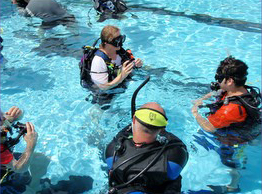 Calling all ADA Members
and Prospective Members! Save the date for Saturday, May
16th for the ADA Scuba Skills Tune-up Event.
Calling all ADA Members
and Prospective Members! Save the date for Saturday, May
16th for the ADA Scuba Skills Tune-up Event.
This exciting event will generate awareness of ADA and encourage new members to join. ADA will reach out to the community and provide an opportunity for lapsed scuba divers to brush up on their skills in a relaxed, friendly environment. It will also provide an opportunity for prospective ADA members to meet and get acquainted with the membership, learn about our dive trips and join ADA! New this year – non-divers can Discover Scuba Diving in the pool and experience diving for the very first time.
Date: Saturday, May 16, 9am to 1pm
Location:
A.D. Barnes Park Park Pool
3401 SW 72 Avenue
Miami, FL 33155
(305) 666-5883
Cost: Free to current paid-up ADA members; $25.00 one-day only membership promotion for certified divers wishing to join ADA at the event – offer available to new members only. Discover Scuba diving is $25.00 which includes a provisional ADA membership. Once you complete the open water course and become a certified diver, your ADA membership is free.
Events and Activities: Ongoing Scuba Tune-Up Clinics taught by Safety Officers and PADI-certified scuba instructors. Clinic topics include re-familiarization and assembly of scuba equipment, proper use of equipment, and refresh on the typical pool skills with scuba equipment taught in the Open Water course. Also covered will be safety topics, equipment, dive planning, underwater environment, computer use, etc. Note: This is not the official PADI scuba refresher course and participants do not receive any sort of certification for this event. Discover Scuba Diving is for non-divers to experience diving for the first time in the pool, limited to 8 participants.
Lunch: Poolside lunch served after the pool session compliments of ADA.
Equipment: Participants must bring their own scuba gear – mask, fins, snorkel, BC, regulator and weights. Each participant must also bring one filled air tank. Many local shops will rent the necessary equipment.
Volunteers Needed: If you would like to volunteer for the registration table, lunch setup, clean-up, or clinic instruction, please contact Rachel at rachelhancock7@gmail.com or call 786-316-9852.
Spread the Word and Bring Your Friends! We want to use this event to get in as many new members as possible so please spread the word and bring your friends. There will not be another opportunity to join ADA for just $25 for the rest of the year.
To RSVP or More Info: Contact Rachel Davis at rachelhancock7@gmail.com or call 786-316-9852.
![]()
Be the First On Your Block....
.......to own the new Active Divers Association license
plate frame, and the best part is it's
FREE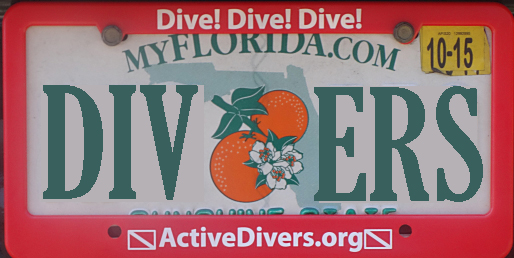 for the asking.
A colorful red and white license plate frame with the ADA
web address is available free to all ADA members. We will
be distributing them at most ADA events. Each member is
asked to install on your cars, and those of your friends
and family. They need not be a member of ADA or even a
diver. We hope to make our name more prominent around S.
Florida, attract new members, and offer more new programs.
Call Lon at 305-251-4975 if you need more frames.
for the asking.
A colorful red and white license plate frame with the ADA
web address is available free to all ADA members. We will
be distributing them at most ADA events. Each member is
asked to install on your cars, and those of your friends
and family. They need not be a member of ADA or even a
diver. We hope to make our name more prominent around S.
Florida, attract new members, and offer more new programs.
Call Lon at 305-251-4975 if you need more frames.
![]()
Active Divers Season Kickoff and Barbecue
--by Dan Baeza

Over 30 veteran and new Active Divers met on March 21st at John U Lloyd State Park Jetty Pavilion to enjoy tasty barbecue and beach diving for its annual Season Kickoff. Our own gourmet chef extraordinaire, Roy Wasson, prepared burgers, chicken, and his own secret chili recipe for the hungry crowd.
We also held our first annual Dive Gear Swap 'n' Shop. Divers brought their gently used dive gear including wet suits, accessories, and scuba-related paraphernalia and engaged in a lively sell and swap fest among their buddies. It was a great garage sale just for divers!

After everyone had their fill of eating and shopping, our guest speaker Amanda R. Costaregni of the Southeast Florida Coral Reef Initiative presented her research findings. Amanda showed how local residents and guests use the reefs in the southeast Florida region using a web-based interactive map. Hosted by the Southeast Florida Coral Reef Initiative (SEFCRI), this research brings together the community of local residents, reef users, business owners, visitors and the broader public in Miami-Dade, Broward, Palm Beach, and Martin counties. Based on the research, the SEFCRI develops management recommendations that can become part of a comprehensive management strategy to ensure healthy coral reefs in the future. (Mouse-over the photo at right to see Amanda lecturing the picnicers.)
Many thanks to all the volunteers who selflessly donated their time and talents to making the 2014 dive season a success. Our club exists for the sole purpose of serving its members. The hundreds of hours put in by our volunteers each year is the lifeblood that keeps our club vital. Pictured at left are some of our volunteers posing with their certificates of appreciation.
![]()
Photography Part 3 - Choosing a Camera
--By Dan Baeza
Summary:
- External housings are more versitale and can hold almost any camera available
- Integral housings are more compact and less costly
- All u/w cameras must be leak-resistant, have easily accessible controls, long battery life, and HD video capability
The most perplexing activity for the intrepid photographer is not picking the right subject, but rather picking the right camera. For underwater photography, there are two classes of camera. The first class of camera is the land based device placed in an external underwater housing. The second class of camera has an integral housing. There are advantages and disadvantages to both.
Advantages of an external u/w housing:
- Easier to visually determine whether the housing is leaking
- Virtually any make and model of land camera may be operated in an underwater housing (although some lenses may not fit)
Advantages of an integral u/w housing:
- More compact
- Controls are easily accessible
- Possibility of changing lenses underwater
- Less costly
Once a decision about the type of housing is reached, we can enumerate the common features important to an underwater camera
Desired Features in an underwater camera:
- Pressure resistant, leak resistant, to at least 160 feet
- External viewfinder
- Wide angle lens (28 to 35mm)
- All external controls must be easily accessible
- Autofocus and/or easily accessible manual focus controls
- Auto exposure and/or easily accessible manual exposure controls
- Normal focus to 12 inches
- Macro focus to 1.5 inches (either built-in or interchangeable underwater lenses for normal and macro focus)
- Long battery life
- User-changeable battery
- Underwater color correction (either electronically or with a color-correcting filter)
- USB or wireless transfer port
- Capability to add an external light source and strobe trigger port
- Rapid recycling in photo mode
- HD video capability

There are several camera and camera housing combinations that have the features enumerated above. For example, the Sealife 1400 at $499 and the Intova HD Edge X at $299 cameras with integral housings and have these features. There are too many camera and housing configurations to list, but suffice to say, for enough money, virtually any camera can be placed in an external housing. For example, an underwater housing for a Nikon CoolPix S6300 will cost around $300, plus another $200 for the camera. A high-end SLR camera case can run as much as $1,800 plus the cost of the camera.Post-production software is an important part of the equation as well. At right, is a photo I recently took on a dive trip to Fiji. The phot was taken without a strobe using the Intova HD Edge X camera:
Notice how the photo detail is crisp but washed out, the colors flat and lifeless. Observe also how there is extraneous detail that is incidental and unimportant to the subject.
Now look at the photo below. The useless detail has been cropped, and the underlying colors have been enhanced:

We'll discuss the software end of photo and video photography in a future article. For now, just be aware that image enhancing software is an integral part of underwater photography.
Capturing photos is an exciting aspect and addition to the underwater world and one that will enhance your enjoyment of the sport. Even your mind's eye's most vivid memory pales and distorts compared to the simplest underwater photo you can ever record of the dive. Your photos create a diary that you can view and review, share, publish, and even validate what, when, and where the images you think you saw where actially seen.
Next month month we'll discuss natural lighting, strobes, and movie lights and how recorded images in the underwater environment are affected.
![]()
Florida's coral reefs are home to a fish that you don't want to mess with: scorpionfish. As a close relative of lionfish, they also have venomous spines that can inflict a painful wound. Scorpionfish (also referred to as stonefish in the Pacific) are bottom dwellers and like to hide in cracks and crevasses but are sometimes found in the open near a reef. They eat other fish by opening their large mouths and sucking in any smaller fish that happen by. Scorpionfish camouflage themselves by appearing to be part of the reef or looking like a rock on the bottom. They should not be provoked, stepped on or otherwise bothered to avoid receiving a painful sting from one of its dorsal spines.
![]()
Diving Writers (and Writing Divers)
Wanted
--by
Roy Wasson
Have you ever written a letter to a friend describing your favorite dive at a certain destination? Have you ever written complaint or a complement to a dive equipment manufacturer about something you liked or disliked about a piece of Scuba gear? At the very least, you may have jotted down a recipe for your favorite seafood dish, haven’t you?
All of us have probably expressed an interest in writing about our sport and hobby, but most of us do not have the opportunity to share that creative expression of writing to a large audience of underwater enthusiasts. Now, the opportunity to write articles for publication in the Active Divers Association’s newsletter, The Mouthpiece is available to our readers.
We are always on the lookout for fresh ideas and content for our monthly newsletter and social media publications, so send your submission for review by our editorial staff and you just may see your name in print. Whether you write about a dive you suggest the Club arrange, a sea creature you’ve encountered in the depths, a tip for making diving more enjoyable and safer, or any other topic of interest to our club, you can share your story with others.
Submit your articles to the WebMaster at dmbaeza@bellsouth.net. By submitting an article, you give us the non-exclusive right to edit and/or publish it in a future issue of our newsletter or social media. Be sure to include a phone number with your submittal so that we can contact you if we have questions.
![]()


On March 10, six ADA divers embarked on a legendary journey to the mythical land of Fiji. The name evokes images of white sandy beaches, lush tropical foliage, warm breezes, and aquamarine waters filled with tropical fish of every variety. All that would normally be true except for one fact…. Cyclone Pam. We boarded the Reef Endeavor, a small cruise ship that would be our home for the next seven days, thinking the cyclone would dissipate, or otherwise veer away from us. For a day or two, we cruised toward the northern Fijian islands. Meanwhile, the storm kept building until it became a category 5 cyclone. Although it was projected to cross no nearer than 500 miles away, it was of sufficient size and strength that we would nevertheless feel the effects. By the third day, the seas had built up to 15 feet, stirring up the seas and making diving virtually impossible for more than 24 hours.
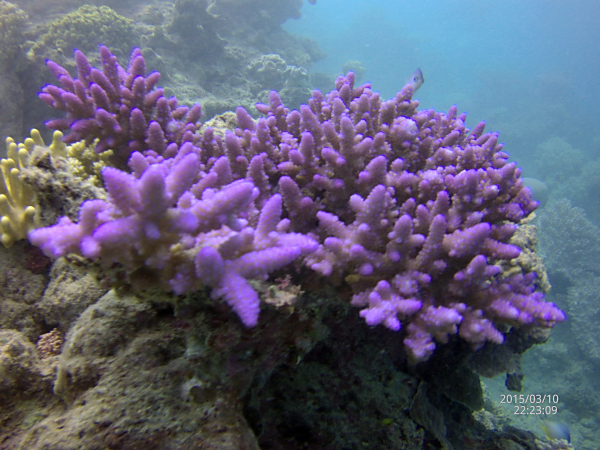

Despite these challenges, we had several great dives. Fiji is known for its varieties of hard and soft corals and we weren’t disappointed. On every dive, we saw brain corals, star corals, broccoli corals, cauliflower corals, as well as numerous varieties of starfish, sea anemones, crinoids, and sea fans. One morning, we dropped 80 feet down on the wall and drifted along the reef, passing fifteen foot high coral formations and tropical fish species too numerous to mention. We finish the dive happy and return to the ship for lunch. After lunch, we motor out to the second dive site. Once again, our luck holds and the waters are calm and clear. We enter the water and quickly descend to sixty feet. The view is spectacular. The coral formations are bigger and denser than on the previous dive. I end up taking hundreds of photos.
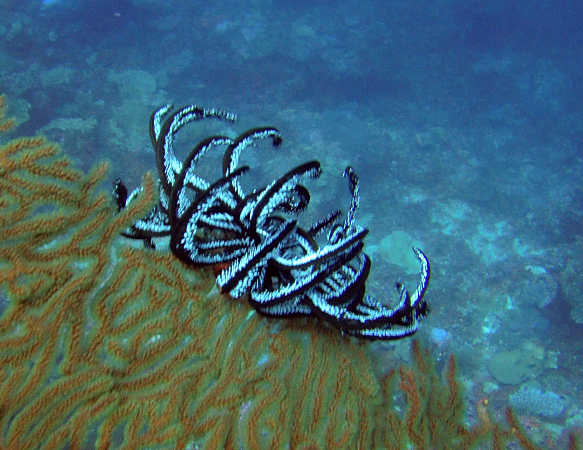 The ship itself is a
cross between a cruise ship and a live-aboard dive
boat. While you would not mistake it for a luxurious
Royal Caribbean or Princess ship, it is several steps
above a pure dive boat experience such as what you
would find on an Aggressor or a Divi ship. The food
was good and plentiful and the crew was top-notch. The
ship carries 74 passengers and 46 crew.
The ship itself is a
cross between a cruise ship and a live-aboard dive
boat. While you would not mistake it for a luxurious
Royal Caribbean or Princess ship, it is several steps
above a pure dive boat experience such as what you
would find on an Aggressor or a Divi ship. The food
was good and plentiful and the crew was top-notch. The
ship carries 74 passengers and 46 crew.
One of the unique aspects of this trip was the opportunity to immerse oneself in the Fijian culture. The Fijians are extremely happy and friendly people. Every day, we took excursions into Fijian villages and towns and met with the village elders. Often, the townspeople would entertain us with a cultural dance, or share a bowl of kava with us. Incidentally, kava is a mildly euphoric tea made from the powdered root of the kava plant. Definitely an interesting experience!
All in all, it was a great trip. The people, the scenery, the reefs, and the culture are memories that I will never forget.
![]()
New Online ADA Dive Calendar Available
--by Daryl Johnson
One of the first things I used to do every spring when the ADA dive calendar is first published is to sit down for 30 minutes and hand copy the dives into my personal paper calendar. With the advent of smart phones and electronic calendars I still had transcribe it all to from the paper newsletter to my calendar, which again took at least 30 minutes. BUT NO MORE!!! With some help from our webmaster Dan Baeza, I took most of the work out of it for you so that with a few clicks on Google you can overlay the ADA dives and events on your personal calendar. All you have to do is to follow the instructions at http://activedivers.org/CalendarInstructions and in no time you will have all the events on your calendar.
It provides other benefits as well, since the club can update the schedule and any changes that occur will automatically show up on your calendar. Also, each event has a link on it to take you to the relevant information on the website. Enjoy!!!
![]()
The First Annual ADA Dive Cruise Is Ready For Booking!!!
We have published several articles in the newsletter
about ADA divers taking what we termed ”Dive Cruises”
and just how great they are. Well now we have an
official ADA Dive Cruise arranged with Princess
Cruises aboard the Emerald Princess on November 14,
2015, departing from Port Everglades in Fort
Lauderdale. During our 7 day cruise we will dive three
fabulous world-class dive locations on this
once-a-year itinerary: Grand Cayman, Roatan and
Cozumel!!! It is really easy to do when no flying is
involved to get to your destination, and the ship
repositions overnight to the next dive location while
you are dining, being entertained, watching “Movies
Under the Stars”, or simply enjoying the voyage. Dan
and I took this cruise last year and had three
outstanding days of diving, gourmet meals, and a
terrific cruise experience.
Double occupancy prices vary according to cabin from as low as $599 per person for an interior cabin to $899 for a balcony (on sale as of this writing,) not including the dive excursions which range from $119 to $149, per diver, per excursion, including all equipment rentals. Our experience has been that if the prices drop (they usually do as the date of the cruise approaches), and you have a deposit down prior to final payment being made, Princess can give you the new rates if you contact them. So to make sure you get the cabin you want, I urge you to make your deposit now rather than later. Final payment is due August 31, 2015, and I recommend that you wait until then to make the final payment. Oh, and by the way, prices are lower if you want to book more than two to a room (four maximum). I did one dive cruise with two other divers in an interior cabin with no problems.
An additional benefit of booking the ADA Group trip is the onboard credit that each cabin will receive depending on how many cabins are booked within the group. So, how simple is it to book this trip? All you have to do is call our Cruise Planner, Karen Bradder at 1-800-901-1172 ext. 41643 and tell her that you want to book the Active Divers Association cruise and make a deposit. That’s it, no muss, no fuss and you will be ready for an outstanding trip with ADA!! Be sure and make your dive reservations as soon as you can after you book the trip as they do occasionally sell out. Better hurry if you want a balcony cabin, they are running out of inventory!!
![]()
4 Spots Remaining - Dive Barbados July 19 -25th
The Active Divers Association is diving Barbados this year, and it's not too late to reserve your spot. Besides the diving, there is a wealth of eco tours and adventures to take in while in Barbados. As the eastern most Island in the Caribbean, it is much more natural than the heavily visited western islands. Take a look at all the activities and sites to visit during this trip at http://barbados.org/index.html for that spare time after a morning of diving with Hightide Watersports. Speaking of diving, here is a list of the dive sites that we may visit: Maycocks Bay, S.S. Stavronikita, Pamir, Silver Bank, Dottin, Carlisle Bay, Bell Buoy, and Cement Factory (Click here for a map and a description of each site).
If you simply want to relax by the pool at the Sugar Cane Club Resort and Spa you can do that too! (Photo from trip advisor, see the rest of the resort at Trip Advisor. )
All this for $989 per diver (plus your airfare). To make a deposit to hold you spot simply go to http://activedivers.org/Barbados2015.html and scroll to the bottom and buy now!
![]()
It was going to be a beautiful wreck dive. Seas were clam, temperature was warm, visibility was good! We tied off on the mooring ball. My daughter was to complete her certification as an open water wreck diver.
I jumped in the water and because of a slight current, descended down the stern line. I was leading Lon. Hand over hand down the anchor line, after 20 feet, I felt so buoyant it was difficult to go further. So naturally I checked my BC. All the air was purged. My hand brushed my waist and I realized that my weight belt was still safely tucked under the seat on the boat. I looked at Lon and signaled that I had to return to the boat. He seemed puzzled at first, but accepted my mimed explanation. So ascending against all the traffic coming down the line, I made my way to the surface. Upon reaching the platform, I sheepishly asked for my weight belt.
Donning the belt, I made my way alone back to the anchor line and down to the wreck. I had to stop and locate my dive buddies who had who had swum on ahead. I located by buddies and the group who were going through their underwater exercise. Looking at my pressure gauge, I noticed that every time I inhaled, the needle fell to zero then gradually built back up. This caused me great concern at 80 feet. I pointed this out to my loving wife and she mouthed …GO… SEE… LON..! I swam to Lon and showed him my gauge. He looked at me in the eye and with a knowing expression, reached over and opened my tank valve. Problem solved! I felt lower than a peacock flounder, and a lot less colorful. I had to follow Lon for the rest of the 50 minute dive with my proverbial tail between my legs. As a Divemaster, is there anything I could say to mitigate this fiasco? Oops!!!
![]()
A fogged mask can ruin any dive. Fogging occurs because of the residue left from manufacturing of the lens and the warm air between the lens and the divers face. Always breathe through your mouth when you have your dive mask on to prevent fogging. Here are some other tips to prevent mask fogging: Spit on the inside of the mask then rub it around with your finger. Dunk the mask briefly in fresh water immediately before diving. Commercial Defog: more effective than spit. Put a few drops of the defogging liquid in the mask, rub it around with a finger, and rinse briefly with fresh water. Baby Shampoo: watered down baby shampoo can be used just like commercial defogging solution. Dish Washing Detergents: be sure to rinse mask before diving as dish washing detergents can really burn the eyes. Toothpaste: Rub some non-abrasive toothpaste on the inside of the mask lens until it coats the glass completely. Rinse the mask gently with fresh water until the lens is clear. Especially helpful on a new mask to remove all remaining manufacturing residue. Potato: Rub some cut potato on the glass, rinse briefly, and dive.
"Why do scuba divers get motion sickness? It's because your feet are telling your brain that you're on solid ground but you're really rocking and rolling on the high seas. Your brain gets confused; you get sick.”
Seasickness or as the French say, Mal de Mer, is among the worst feelings one could encounter. First, you are afraid you will die, and then you are afraid you won't. However, there are many treatments for lessening the symptoms. Listed below are some ways to avoid or lessen seasickness or motion sickness:
- Look up and out. Your brain gets confused with the body, inner ear and eyes all sending different signals. By looking out towards a horizon, your peripheral vision will see the ocean swells that you feel and the whole picture will make more sense to your brain.
- Have a Coca Cola. It contains phosphoric acid and sugars, which are the same ingredients that you find in over the counter nausea drugs.
- Eat some ginger. Ginger cookies, ginger candy or tiny pieces of grated ginger, even Ginger Ale can help.
- Avoid heavy foods. That bacon and eggs breakfast with hash browns and coffee may become fish food.
- Wear a scopolamine patch (Transderm Scop) or take meclizine but take it at least 24 hours prior to going to sea.
- Don't read. Focusing your eyes makes them even more convinced that your middle ears are wrong.
- Be well rested – fatigue can increase your seasickness chances.
- Avoid alcohol
If you do become seasick, let 'er rip. You'll feel better almost immediately. Go to the railing on the leeward side, use a bucket, or ask a crew member where to go to hurl. Do not use a toilet or a trash can. Don't be embarrassed, you are not the first person to get seasick. Lastly, the only proven and really effective way to cure seasickness is to hug a palm tree, preferably on dry land. Really!!
![]()
Shore
Diving in South Florida - Oakland Park Blvd
--by Jerry Kosakowski
This spot is located at Oakland Park Blvd., in Fort Lauderdale. Take A1A south from Oakland Park. Once you reach NE 27, head East to North Atlantic Blvd. There is metered parking. Enter here and swim straight out. As always, bring a dive flag. This is a patch reef with soft and hard corals. Enjoy this on a nice sunny day. The reef varies from 10 to 20 feet deep. There are no lifeguards. Bring a friend and share your experience.
There are horse, dog, and car races. But shark races? Yep, the Guy Harvey Great Shark Race will be launched from two sites this year. The Guy Harvey Research Institute at Nova University is fishing for dollars to conduct critical research on shark migratory, feeding, and mating patterns. About one-third of open ocean shark species are threatened with extinction. The research institute is asking businesses or persons to purchase satellite tracking tags, which cost $5,000 each, and become sponsors. The race consists of two divisions. One which begins April 2, will be mako sharks tagged in Mexico. The second, which begins June 1, will be white tips tagged in Grand Cayman. The shark which travels the greatest distance in 6 months will earn its sponsor a free fishing trip. For more info go to GreatSharkRace.com
![]()
Have You Moved or Changed Email Addresses Lately?
If so, please email or call us with your current information. you may send an email to: Dr. Dan Baeza, Membership Chair at dmbaeza@bellsouth.net. You can also call Dan at 954-260-8225 and leave a message with your new contact information.



Show your pride in the best dive club anywhere! Sizes small, medium, large, xlarge, xxlarge. Some tank tops available also. All shirts are $10 each. CALL LON AT 305-251-4975 AND PLACE YOUR ORDER TODAY!. Lon will deliver it to you on your next dive

![]()
Want your newsletter delivered via snail-mail? Contact Carol Cox at ccox911@att.net and request a printed copy. Be sure to put "ADA Newsletter" in the subject.
